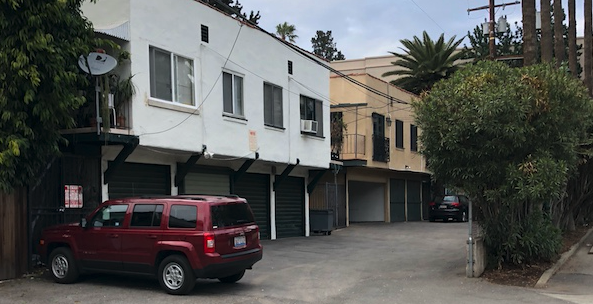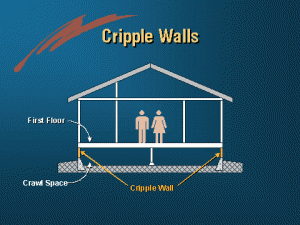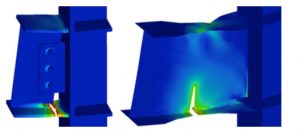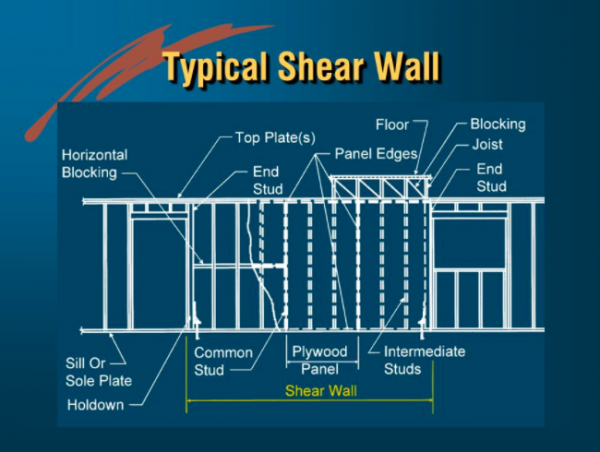The City of West Hollywood today released a list of the addresses of 820 buildings that are potentially vulnerable to earthquake damage.
The list was compiled by Degenkolb Engineers, a city contractor, and is based on a “drive-by” survey. That means that buildings on the list may not actually be exceptionally vulnerable to earthquake damage. However, those buildings, as observed from the street, have characteristics of at-risk buildings. The map above, prepared by Jim Garrecht of ANG News, shows the locations of those buildings with the exceptions of three addresses (967 Dozens Dr., 8107 1/2 Norton Ave. and 1223 1/2 Havenhurst Drive), which failed to appear.
Owners of buildings on the list, which can be seen by clicking here: EARTHQUAKE AT-RISK BUILDING ADDRESSES will have to engage the services of a consultant to determine if there is an actual risk and, if there is, a city ordinance requires them to “retrofit” such buildings to protect them from seismic, or earthquake, damage.
A retrofit might have a financial impact on tenants if owners are allowed to pass the retrofit costs along. If owners can do that, and how they can do that, has been the subject of several meetings of the city’s Rent Stabilization Commission, which will continue addressing the issue at public meetings for the next few months. It finally will make a recommendation to the City Council for adoption.
The retrofit ordinance applies to four categories of buildings:

1) Wood-frame buildings with soft, weak or open front walls, which would include some of those with parking on the first floor. Seismic strengthening will be mandatory for weak buildings of that type for which a construction permit was applied for before Jan. 1, 1978. A report from the city’s Community Development Department estimates there are 780 such buildings in West Hollywood. The report recommends priorities for addressing issues with these buildings, with those of 16 or more housing units ranking first, followed by three-story buildings with fewer than 16 units and then all others. Owners of these buildings will have five years to complete any necessary fixes.
.

2) Wood-frame buildings with “cripple walls” and “sill plate anchorage.” A cripple wall is less than a full story tall and usually is found between the first floor and the foundation of a building. A sill plate is the bottom horizontal piece, often of wood, to which vertical parts of a wall are attached. In older houses such sills sometimes are too close to the ground and can rot out under a building. Seismic strengthening for such buildings is not mandatory but is up to the owner.
3) “Non-ductile” concrete buildings, which are buildings with rigid and unbendable concrete walls that are unlikely to flex during an earthquake. Seismic retrofitting of those buildings is mandatory. The Community Development Department report says that construction of such buildings continued until approximately 1980, after which “building codes required ductile detailing of concrete buildings.” The retrofit requirements will apply to those buildings built under codes enacted before 1979. The city estimates there are 55 non-ductile concrete buildings in West Hollywood and another 65 buildings that might fall into that category after additional inspections. Owners of such buildings will have 10 years to complete fixes of major problems and 20 years to conduct a complete retrofit. The top priority for such buildings is those with eight or more stories, followed by those with three to seven stories and then those with one or two stories.

4) Pre-Northridge steel moment frame buildings. These are buildings with load-bearing steel frames in which the beams are rigidly connected to the columns. Many such buildings were found after the 1994 Northridge earthquake to have suffered fractured columns because the steel was not flexible enough. Each of the 31 buildings in this category will have to be analyzed by an engineer to determine what flaws they might have. Owners of these buildings will have to meet the retrofit deadlines established for non-ductile concrete buildings.
The challenge faced by the city is finding a way to balance the need for building owners who must pay for retrofits to make a reasonable profit while helping tenants continue to afford their apartments. Mayor John Heilman and several City Council members have said they are worried that apartment building owners required to assume the entire retrofit costs will decide to sell their buildings instead, taking them off the city’s rent-stabilized apartment market.
Options for Sharing Costs with Tenants
Two options for having tenants share the cost of earthquake retrofits of rent-stabilized buildings have been discussed in recent Rent Stabilization Commission meetings:
—Net-Operating Income Increase. This would permit a rent increase in the event the annual cost of the retrofit, as calculated over a city-designated number of years, would reduce the building owner’s net operating income from the building to less than that of a particularly designated year. The city currently allows such rent increases if a building owner can document that he or she is making less profit than in the past because of improvements to the building.

That would mean an increase for some renters in what the city currently permits for rent-stabilized apartments, which is a maximum of 60% of the annual increase in the Consumer Price Index. This year’s maximum increase was 1.75%. The increase also would be permanent, meaning it would not end after the increase has generated enough additional revenue to cover the cost of the retrofit.
A recent presentation at the Rent Stabilization Commission offered an example of an owner of a ten-unit, rent-stabilized apartment building whose current income from the building is $85,000 a year. If that owner took a 30-year loan of $104,000 to retrofit the building at an interest rate of 8.5%, the owner would by paying $9,800 a year on that loan. However, the owner’s operating profit on the building would be only $78,000 a year, a reduction of $7,000 from profit in the designated previous year. To cover that cost, the owner would have to increase the rent on each of the 10 units by $23 a month.
—Cost Recovery Increase. This option is likely to be favored by tenants. It would allow the building owner to recover a designated percentage of the cost of the retrofitting over a period of time set by the city.
Using the example of the 10-unit building with a 30-year, $104,000 loan that requires a $9,800 annual payment, the monthly rent increase would be $82 if the city permits the landlord to pass through 100% of the cost of the loan over 30 years. However, if the city allowed the owner to pass along only 50% of the annual loan cost, the rent increase would be $41 a month.
The City Council would have the authority to decide whether the “cost recovery” rent increase would end at the end of the designated period or whether it would be permanently incorporated into a tenant’s rent.
The City of Los Angeles uses the cost recovery system. It allows a building owner to pass through only 50% of the cost of retrofitting over a 10-year period. It also sets the maximum increase in the monthly rent at $38. And it factors that increase into the maximum allowable rent for rent-regulated apartment buildings. San Francisco also uses the cost recovery process. It allows the building owner to pass through 100% of the annual cost of a retrofit over 20 years, but limits the actual amount to no more than 10% of the monthly rent. That increase is not included in maximum allowable rent calculation.
WEHOville will publish advance notices of public meetings regarding seismic retrofit issues, including financing options. The City of West Hollywood also maintains a page on its website with information about the issue.
Address of the Possibly At-Risk Buildings
The addresses of the buildings identified by Degenkolb as being possibly at risk are listed in alphabetical order on the attached document, which you can download to your computer: EARTHQUAKE AT-RISK BUILDING ADDRESSES

Drive by inspection is so arbitrary. No noteable damage by Northridge quake at 1264 N. kings Rd. Survived the Sylmar quake. If property owner enhances value of property by bringing it up to code isn’t that their obligation and to their benefit?
The pass through fee to the tenants would be an investment in the property and only makes sense if the tenants then have an ownership stake in the property.
Are the landlords willing to give a portion of the ownership of these buildings to the tenants for making this investment? If they are not, then the tenants should NOT be required to make the investment.
If this is the law, the landlords should be required to maintain their buildings just like any other building owner. Why is this even a discussion?
4 years ago my building went up for sale in West Hollywood. Another tenant, and I were close with our landlord. So we knew exactly what each unit was renting for. When we ran the numbers we came up with a price of 2.8 million. The landlord sold the building for $4 million cash. Which means the current buyer “who was a trust fund kid who’s dad gave him the money to buy the property” was already NOT making a profit when he started. Junior put about $100,000.00 into the building remodeling a few of the units, and then flipped… Read more »
Did they leave off all condo buildings and only include business, hotels and apartments? There are some huge tower buildings that I would think might be vulnerable but none appear on the list. I thought maybe they are left off the list because they are not a part of the ordinance since they are exempted.
My complex/lot has two buildings, they have different addresses. Only one would be visible from the street if it was a true drive-by. The building closer to the street has been marked at risk, but there’s nothing for my structure. Wondering if this is an intentional or a flaw because the address. The street facing building does have a garage under it, while ours does not. Who do we go to for clarification?
How is it the Library (2012) and WeHo City Hall both made this list?
It’s notable that the two buildings shown in the photo as examples of soft-story wood frame buildings are not actually identified as “potentially vulnerable” on the map. The method of “drive-by” surveying is often plagued by false identifications, so as with buildings that are included in the list one hopes there is a mechanism to further investigate those that are not.